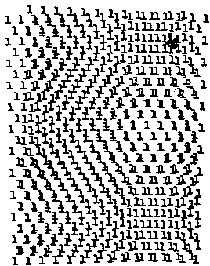| >>> | weblog context |
|
| home | site map | about context | lang >>> español | |
|
> interact with the digital world |
|
|
|
|
|
digital poetry festival The festival E-Poetry 2001 will focus on works in networked and programmable media, kinetic/visual works, hypertext, and multiple practices in digital media. Featured poets will read, perform, and exhibit works that currently define the state of the art in digital poetries. The festival will dialog on topics such as the creation, dissemination, and aesthetics of digital media poetry. Festival will provide a context for readings, conversations and social interactions. "It will be an occasion for people who have worked together for years, in many cases, to meet in person for the first time. I am very much looking forward to seeing live presentations of these vital artworks, to the panels, and to feeling the combined energy of these pioneers of New Media writing," said *Loss Pequeño Glazier*, conference coordinator and director of the Electronic Poetry Center (EPC), that sponsors the festival. From *Lit [art] ure -- Literature enters the 21st Century*
|
|
|
|
|
a base for digital poetry Founded in 1994, the *Electronic Poetry Center (EPC)*, sponsored by State University of New York at Buffalo, is a resource for innovative writing. "The EPC is a ground-breaking innovation in the world of the Web since it provides an edited collection of primary literary texts." EPC offers one of the world's greatest poetry collections. "The EPC recognizes that distribution has been a central problem for poetry (and poetry communities), the bulk of which has been and continues to be printed by the small press. Our aim is to provide access to generous range of writing which mainstream bookstores, publishers and, increasingly, libraries are unable or unwilling to make available." To this end, the Center offers fairly extensive information about small presses and publishers.
|
|
|
|
|
poetry that cannot occur on paper "If we define e-poetry as: (1) writing/programming that engages the procedures of poetry to investigate the materiality of language; and as (2) work that cannot occur in any other medium, then we begin to approach a working definition. ("Writing" is used here in a larger sense than its sense as "typography characters as transparent carriers of meaning" and can involve images, applets, characters which can't be interpreted, etc.) This definition will further take shape if we examine the various practices that constitute e-poetry." From *Viz Études: an Inventory & Prospectus for E-Poetics by Loss Pequeno Glazier*
|
|
|
|
|
at the intersection of page and screen "Until recently, poetry as a literary art has been a page art, meaning its textures (its feel and appearances, its arrangements) have been strictly aligned with the physical surfaces on which it has appeared - namely, for most Western readers at least, the printed page and the paper book. "Screen space" implies a quasi-new location for the activity of poetry. What qualifies recent innovations in digital-based poetry, however, are its allegiances (implicit and explicit) to the page or ink-based poetries from which it has evolved. Digital poetry exists at the intersection - historically, aesthetically - of page and screen. A closer look at the nature of this intersection might help contextualize recent efforts... Visual-Kinetic poetries in the space-time of digital codification convey both a continuation and an acceleration of traditional activities - most notably the Visual-Concrete poetry and Kinetic Art movements of the 1950's and 60's." From *Virtual Skin by William Marsh*
|
|
|
|
|
new media poetry Is the term coined by Eduardo Kac refering to "innovative poetics developed with new media (including computers, video, holography and the Internet)." From their selected bibliography compiled for *Leonardo magazine* "If one is concerned with the development of a new poetry for the digital age, it is important to write visual poetry in a medium different than print, a medium that is fresh and the conventions of which are yet to be invented. To me, holography is such a medium, but I must point out that the use of new media does not constitute, by itself, a standard of quality or of authentic contribution to the repertoire of experimental writing... It is this generation's challenge to create dynamic electronic and photonic texts that recover the conceptual power and the mysterious beauty of language." From *Holopoetry and Beyond by Eduardo Kac*
|
|
|
|
 |
p0es1s approach During 2000, the festival "Schrift und Bild in Bewegung" ('word and image in motion') taked place in Germany. A part of the festival was the electronic exhibition "p0es1s". Now p0es1s "is a virtual site for advanced possibilities to expand poetry to the field of multimedia and the internet: hybrid texts between word, image, and sound, which can only be electronically produced, stored, distributed, and received. For the users this means poetry, "poesis" in its very literal sense: to make experiences, experiments as aesthetic self-observation and self-creation." From *p0es1s site* "P0es1s specifically connects itself in the tradition of experimental and intermedial poetry of the 20th century. Here, the digital turn is not as distincitive as in other spheres because for a long time Intermedia has already served as an area where word and image come to a "conceptual fusion" (*Dick Higgins*), where multi-lineality, the active participation of the audience in the artistic process and the actual newest media have been tested...Thus "p0es1s" functions as a kind of anchor "on the high 'sees' in the Turing galaxy". Where the journey will take us remains fortunately open." From *A Hyperlink: "p0es1s - international digital poetry"* by Friedrich W. Block.
|
|
|
|
|
|
|
source :: |
E-POETRY, 2001: An International Digital Poetry Festival :: references :: grafik |
|
|
|
|
| home | site map | about context | lang > español | |
context weblog >>> http://www.straddle3.net/context